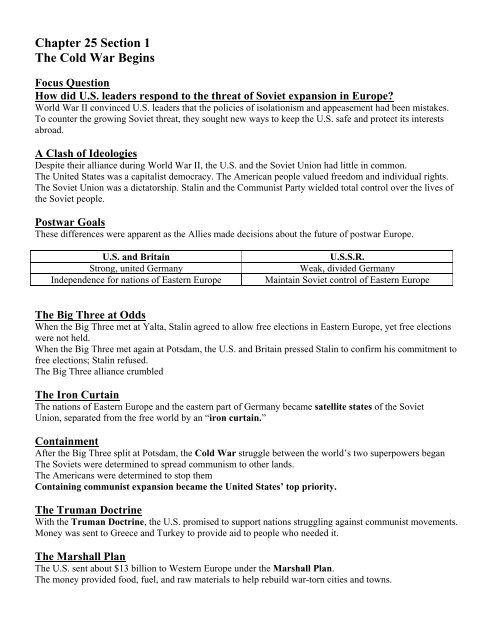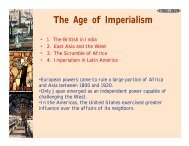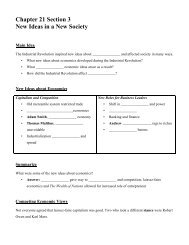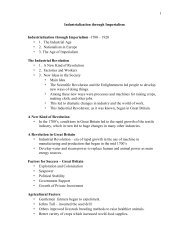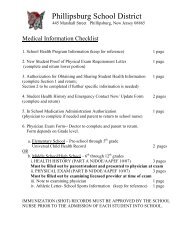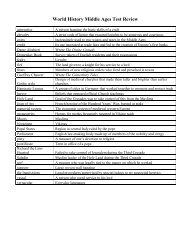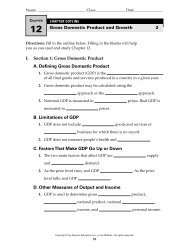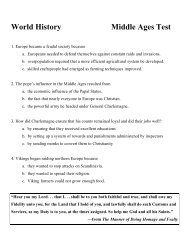Chapter 25 Section 1 The Cold War Begins
Chapter 25 Section 1 The Cold War Begins
Chapter 25 Section 1 The Cold War Begins
You also want an ePaper? Increase the reach of your titles
YUMPU automatically turns print PDFs into web optimized ePapers that Google loves.
<strong>Chapter</strong> <strong>25</strong> <strong>Section</strong> 1<br />
<strong>The</strong> <strong>Cold</strong> <strong>War</strong> <strong>Begins</strong><br />
Focus Question<br />
How did U.S. leaders respond to the threat of Soviet expansion in Europe?<br />
World <strong>War</strong> II convinced U.S. leaders that the policies of isolationism and appeasement had been mistakes.<br />
To counter the growing Soviet threat, they sought new ways to keep the U.S. safe and protect its interests<br />
abroad.<br />
A Clash of Ideologies<br />
Despite their alliance during World <strong>War</strong> II, the U.S. and the Soviet Union had little in common.<br />
<strong>The</strong> United States was a capitalist democracy. <strong>The</strong> American people valued freedom and individual rights.<br />
<strong>The</strong> Soviet Union was a dictatorship. Stalin and the Communist Party wielded total control over the lives of<br />
the Soviet people.<br />
Postwar Goals<br />
<strong>The</strong>se differences were apparent as the Allies made decisions about the future of postwar Europe.<br />
U.S. and Britain<br />
Strong, united Germany<br />
Independence for nations of Eastern Europe<br />
U.S.S.R.<br />
Weak, divided Germany<br />
Maintain Soviet control of Eastern Europe<br />
<strong>The</strong> Big Three at Odds<br />
When the Big Three met at Yalta, Stalin agreed to allow free elections in Eastern Europe, yet free elections<br />
were not held.<br />
When the Big Three met again at Potsdam, the U.S. and Britain pressed Stalin to confirm his commitment to<br />
free elections; Stalin refused.<br />
<strong>The</strong> Big Three alliance crumbled<br />
<strong>The</strong> Iron Curtain<br />
<strong>The</strong> nations of Eastern Europe and the eastern part of Germany became satellite states of the Soviet<br />
Union, separated from the free world by an “iron curtain.”<br />
Containment<br />
After the Big Three split at Potsdam, the <strong>Cold</strong> <strong>War</strong> struggle between the world’s two superpowers began<br />
<strong>The</strong> Soviets were determined to spread communism to other lands.<br />
<strong>The</strong> Americans were determined to stop them<br />
Containing communist expansion became the United States’ top priority.<br />
<strong>The</strong> Truman Doctrine<br />
With the Truman Doctrine, the U.S. promised to support nations struggling against communist movements.<br />
Money was sent to Greece and Turkey to provide aid to people who needed it.<br />
<strong>The</strong> Marshall Plan<br />
<strong>The</strong> U.S. sent about $13 billion to Western Europe under the Marshall Plan.<br />
<strong>The</strong> money provided food, fuel, and raw materials to help rebuild war-torn cities and towns.
Divided Germany<br />
Germany, and the city of Berlin, became flashpoints in the <strong>Cold</strong> <strong>War</strong>.<br />
After the war, Germany was divided into four zones.<br />
<strong>The</strong> zones controlled by the U.S., Britain, and France were combined to form West Germany.<br />
<strong>The</strong> Soviet zone became East Germany.<br />
Divided Berlin<br />
Berlin was also divided.<br />
<strong>The</strong> zones controlled by the U.S., Britain, and France were combined to form West Berlin.<br />
<strong>The</strong> Soviet zone became East Berlin.<br />
<strong>The</strong> Berlin Blockade<br />
West Berlin was controlled by the Allies.<br />
<strong>The</strong> prosperity and freedoms there stood in stark contrast to the bleak life in communist East Berlin.<br />
Determined to capture West Berlin, Stalin blockaded the city, cutting off supplies.<br />
In response, the U.S. and Britain sent aid to West Berlin through a massive airlift.<br />
<strong>The</strong> Berlin Airlift<br />
<strong>The</strong> Berlin airlift saved West Berlin and underscored the U.S. commitment to contain communism.<br />
• <strong>The</strong> Russian blockade lasted from 24 June 1948 to 11 May 1949, but the airlift continued for several<br />
more months<br />
• <strong>The</strong> airlift cost the United States $350 million; the UK £17 million and Western Germany 150<br />
million Deutschmarks<br />
• At the height of the operation, on April 16 1949, an allied aircraft landed in Berlin every minute<br />
• 124,420,813 miles were flown during the airlift. A total of 277,804 flights<br />
<strong>Cold</strong> <strong>War</strong> Alliances<br />
As <strong>Cold</strong> <strong>War</strong> tensions mounted, both sides formed military alliances for collective security.<br />
Belgium<br />
Canada<br />
Denmark<br />
France<br />
Greece<br />
Iceland<br />
Italy<br />
Luxembourg<br />
NATO<br />
Netherlands<br />
Norway<br />
Portugal<br />
Turkey<br />
United Kingdom<br />
United States<br />
West Germany<br />
<strong>War</strong>saw Pact<br />
Albania<br />
Bulgaria<br />
Czechoslovakia<br />
East Germany<br />
Hungary<br />
Poland<br />
Romania<br />
Soviet Union


